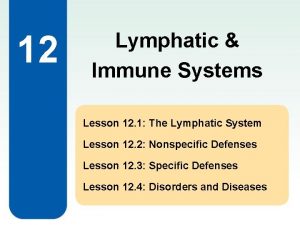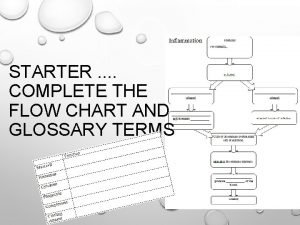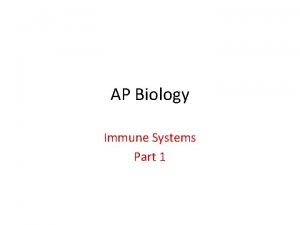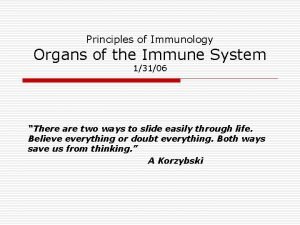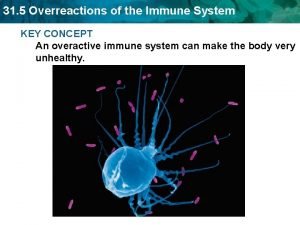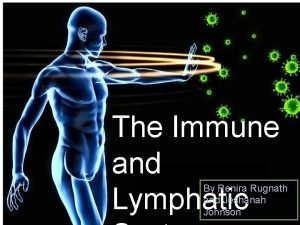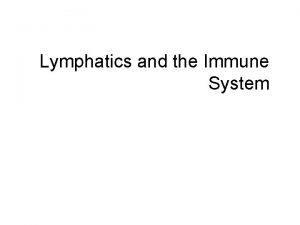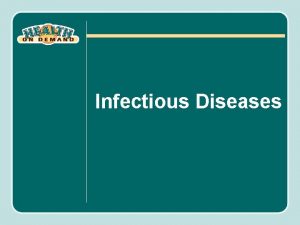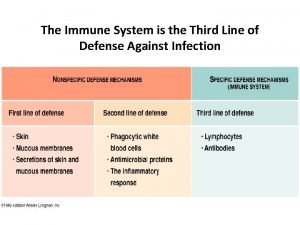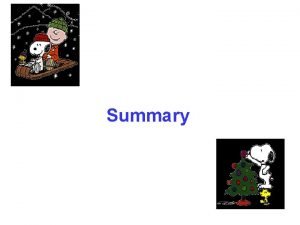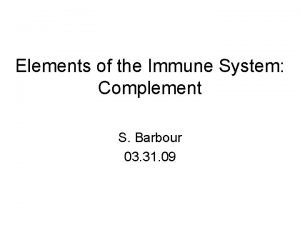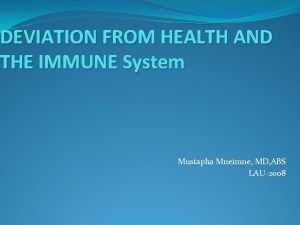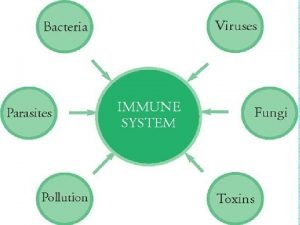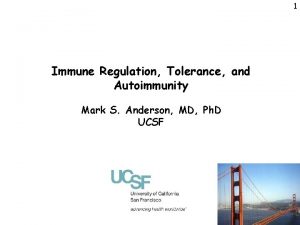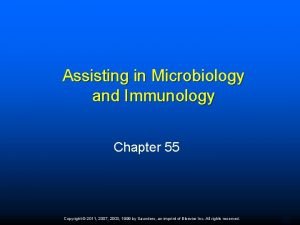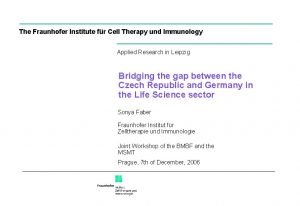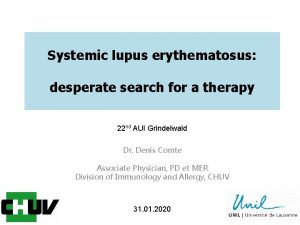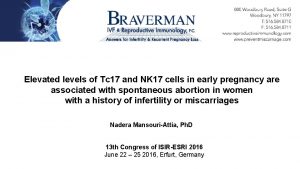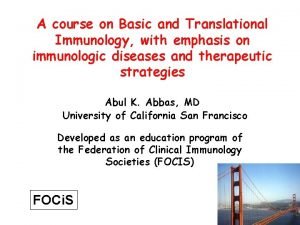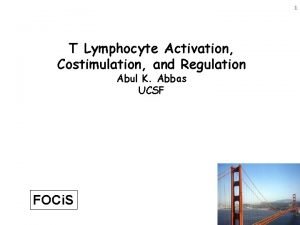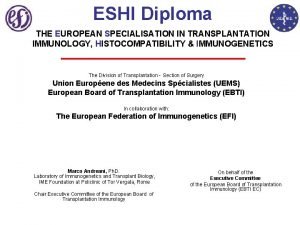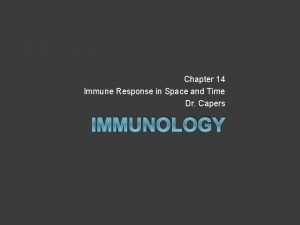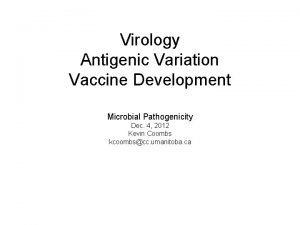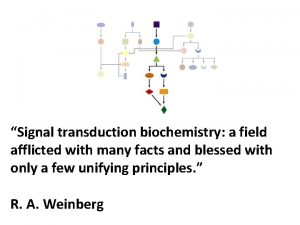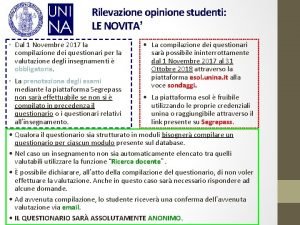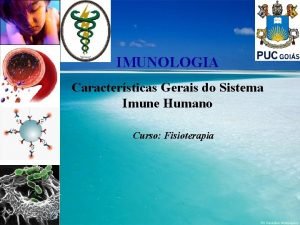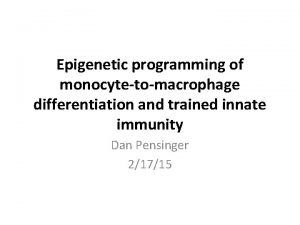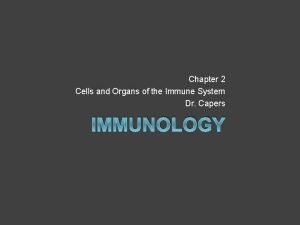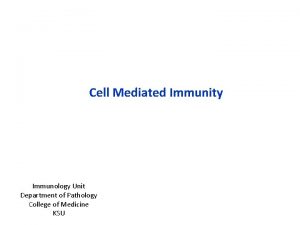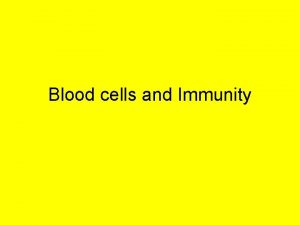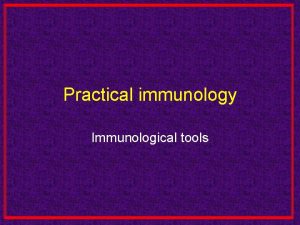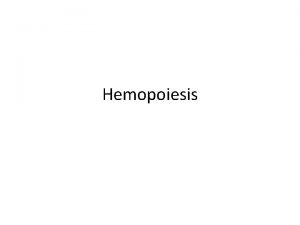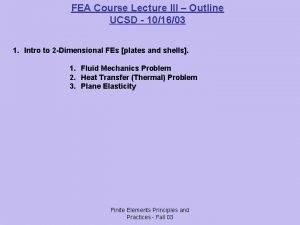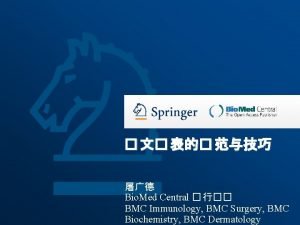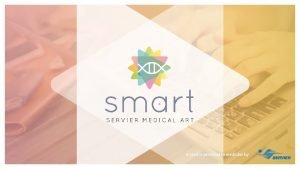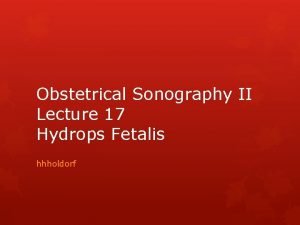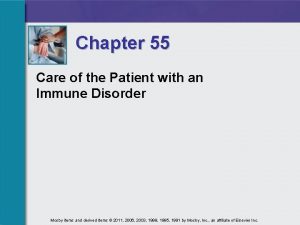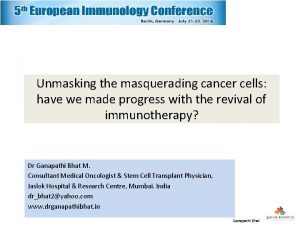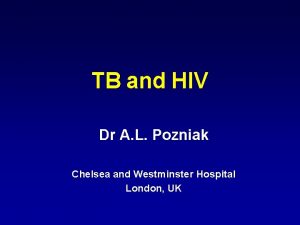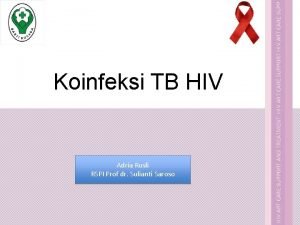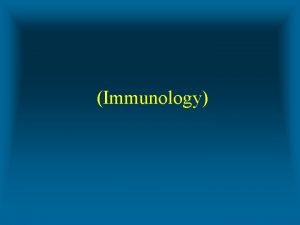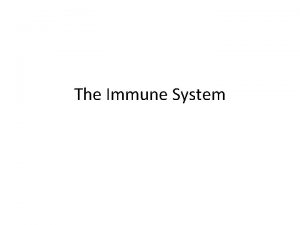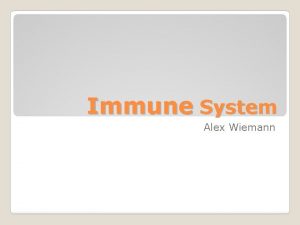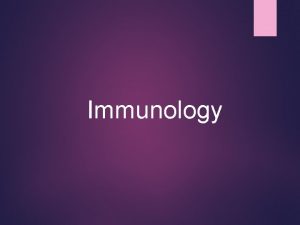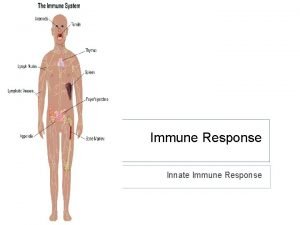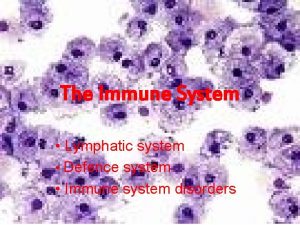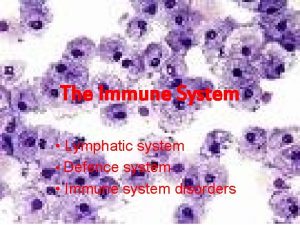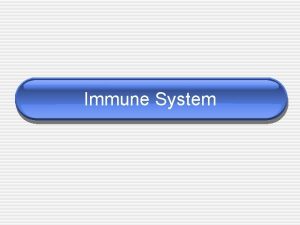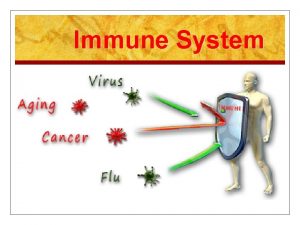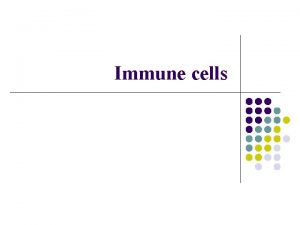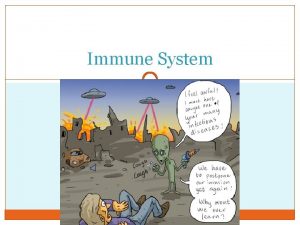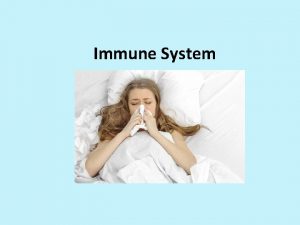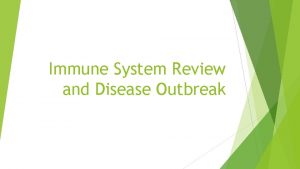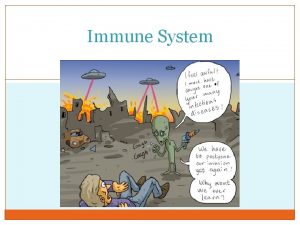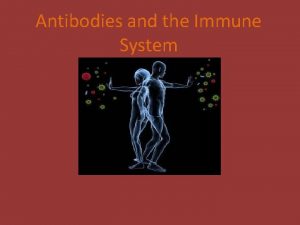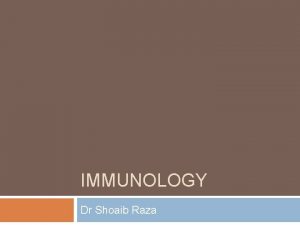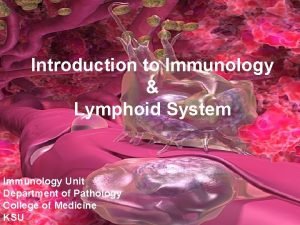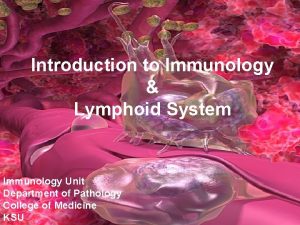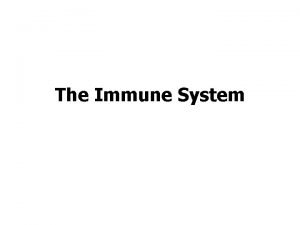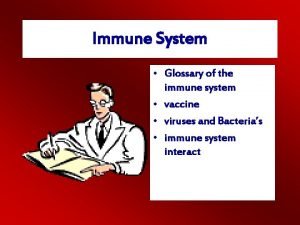Introduction to Immunology IMMUNOLOGY AND THE IMMUNE SYSTEM


























































- Slides: 58

Introduction to Immunology

IMMUNOLOGY AND THE IMMUNE SYSTEM Immunology Study of the components and function of the immune system Immune System Molecules, cells, tissues and organs which provide nonspecific and specific protection against Microorganisms Microbial toxins Tumor cells Crucial to human survival

THE IMMUNE RESPONSE AND IMMUNITY Immune response Innate (non-specific) Adaptive (specific) Primary Secondary Immunity State of non-specific and specific protection Acquisition of Immunity Natural Artificial

NATURALLY ACQUIRED IMMUNITY Active Antigens Innate enter body naturally with response of and adaptive immune systems Provides long term protection Passive Antibodies pass from mother to Fetus across placenta Infant in breast milk Provides immediate short term protection

ARTIFICIALLY ACQUIRED IMMUNITY Active Antigens enter body through vaccination with response of Innate and adaptive immune systems Provides long term protection Passive Antibodies from immune individuals injected into body Referred to as Immune serum globulins (ISG) Immune globulins (IG) Gamma globulins Provides immediate short term protection

FUNCTION OF THE IMMUNE SYSTEM To protect humans from pathogenic microorganisms Pathogenic microorganisms (Pathogens) Microorganisms capable of causing infection and/or disease Infection Ability of pathogen to enter host, multiply and stimulate an immune response Disease Clinical manifestations associated with infection

DEFENSE MECHANISMS OF HUMAN HOSTS Innate Mechanisms (Innate immunity) First line of defense Non-specific Adaptive Mechanisms (Adaptive immunity) Second line of defense Highly specific with memory Cooperation between mechanisms

ORIGIN OF CELLS OF THE IMMUNE SYSTEM Derived from common progenitor cell in bone marrow Pluripotent hematopoietic stem cell Progenitor Stem Cells Erythroid lineage Myeloid lineage Erythrocytes and Megakaryocytes Monocyte/macrophage, dendritic cells, PMN’s, mast cells Lymphoid lineage Small and large lymphocytes


CELLS OF INNATE AND ADAPTIVE IMMUNITY Myeloid Lineage Neutrophil Eosinophil Principal defender against parasites Basophil Principal phagocytic cell of innate immunity Functions similar to eosinophils and mast cells Referred to as Polymorphonuclear leukocytes (PMN’s) Nuclei are multilobed (2 to 5) Granulocytes Cytoplasmic granules



CELLS OF INNATE AND ADAPTIVE IMMUNITY Myeloid lineage Monocytes Leukocytes with bean shaped or brain-like convoluted nuclei Circulate in blood with half life of 8 hours Precursors of tissue macrophages Mononuclear phagocytic cells in tissue Derive from blood monocytes Participate in innate and adaptive immunity


CELLS OF INNATE AND ADAPTIVE IMMUNITY Myeloid lineage Dendritic cells Cells with dendriform (star shaped) morphology Interdigitating reticular cells (synonym) Capture and present antigens to T lymphocytes Mast cells Located in mucous membrane and connective tissue throughout body Major effector cell in allergy Modulation of initial immune response




CELLS OF INNATE AND ADAPTIVE IMMUNITY Lymphoid Lineage Large lymphocytes (large granular lymphocytes) Natural killer (NK) cells (CD 16, CD 56) Innate immunity to viruses and other intracellular pathogens Participate in antibody-dependent cell-mediated cytotoxicity (ADCC) Small lymphocytes B cells (CD 19) T cells (CD 3, CD 4 or CD 8) Adaptive immunity Lymphocytes refers to small lymphocytes

THE CLUSTER OF DIFFERENTIATION (CD) A protocol for identification and investigation of cell surface molecules CD number assigned on basis of 1 cell surface molecule recognized by 2 specific monoclonal antibodies CD nomenclature established in 1982 1 st International Workshop and Conference on Human Leukocyte Differentiation Antigens (HLDA)

THE CLUSTER OF DIFFERENTIATION (CD) CD markers on leukocytes Granulocyte CD 45+, CD 15+ Monocyte CD 45+, CD 14+ T lymphocyte CD 45+, CD 3+ T helper lymphocyte CD 45+, CD 3+, CD 4+ T cytotoxic lymphocyte CD 45+, CD 3+, CD 8+ B lymphocyte CD 45+, CD 19+ Natural killer cell CD 45+, CD 16+, CD 56+, CD 3 -




COMPLETE BLOOD COUNT WITH DIFFERENTIAL (CBC WITH DIFF) References Ranges Erythrocytes (RBC) Thrombocytes (Platelets) Leukocytes (WBC) Neutrophils Band neutrophils Eosinophils Basophils Lymphocytes Monocytes 4. 0 to 5. 4 M/u. L 145 to 400 K/u. L 4. 8 to 10. 8 K/u. L 40 to 74 % 0 to 9 0 to 6 0 to 1 15 to 47 0 to 12

LYMPHOCYTES, LYMPHOID TISSUES AND ORGANS Lymphocytes originate in bone marrow Lymphoid tissues and organs Primary Development and maturation of lymphocytes Bone Marrow (B cells) and thymus gland (T cells) Secondary Mature lymphocytes meet pathogens Spleen, adenoids, tonsils, appendix, lymph nodes, Peyer’s patches, mucosa-associated lymphoid tissue (MALT)


THE LYMPHATIC SYSTEM Lymph Fluid and cells in lymphatic vessels Lymphatic vessels Collect and return interstitial fluid to blood Transport immune cells throughout body Transport lipid from intestine to blood Lymph nodes Kidney shaped organs at intervals along lymphatic vessels Other secondary lymphatic tissues and organs

LYMPHOCYTES AND THE LYMPH NODES Naïve lymphocytes circulate between blood, lymph and secondary lymph nodes Pathogens from infected tissue sites are picked up by lymphatic vessels and arrive at closest lymph node T and B cells congregate at specific regions of nodes Architecture and size of nodes change in response to activation of lymphocytes



THE INNATE IMMUNE RESPONSE Mediated (initiated) by phagocytes, NK cells and soluble proteins Phagocytes Cells specialized in the process of phagocytosis Macrophages Reside in tissues and recruit neutrophils Neutrophils Enter infected tissues in large numbers Recognize common molecules of bacterial cell surface using a few surface receptors Phagocytosis Capture, engulfment and breakdown of bacterial pathogen


THE INNATE IMMUNE RESPONSE Inflammatory response enhances phagocytosis through acute phase proteins Mannose-binding lectin (MBL) C-reactive protein (CRP) Binds to bacterial surface with particular spatial arrangement of mannose or fucose Binds to phosphorylcholine on bacterial surface Complement Set of proteins which bind to bacterial surface Inflammatory response Accumulation of fluid and cells at infection site (swelling, redness, heat and pain)


THE ADAPTIVE IMMUNE RESPONSE Creates millions of different B and T cells for specific antibody-mediated and cell-mediated immunity Antibody-Mediated Immunity (AMI) Involves B lymphocytes, plasma cells and antibodies Humoral immunity Name derives from antibodies found in body fluids (humors old medical term) Cell-Mediated Immunity (CMI) Involves T lymphocytes, antigen-presenting cells and MHC (major histocompatibility complex) molecules Cellular immunity

ANTIBODY-MEDIATED (HUMORAL) IMMUNITY Directed against extracellular microorganisms and toxins B-lymphocytes (B cells) Differentiate into plasma cells which produce antibodies Function as antigen-presenting cells (APC’s) Classification of Antibodies (Immunoglobulins) Immunoglobulin M (Ig. M) Immunoglobulin G (Ig. G) Immunoglobulin A (Ig. A) Immunoglobulin D (Ig. D) Immunoglobulin E (Ig. E)

CELL-MEDIATED IMMUNITY (CMI) Directed against intracellular microorganisms Non-phagocytic cells and phagocytic cells T-lymphocytes (T cells) Differentiate into effector cells following antigen presentation by antigen presenting cells (APC’s) Functional types of T cells Helper (CD 4 T cells) TH 1 and TH 2 cells Cytotoxic (CD 8 T cells) Regulatory CD 4 and CD 8 Tregs


THE NATURE OF ANTIGENS Historically named as antibody generators Molecule which stimulates production of and binds specifically to an antibody Contemporary view distinguishes between Antigen Molecule which can bind to specific antibody but cannot elicit adaptive immune response Immunogen Molecule which can stimulate adaptive immune response Best immunogens are proteins with MW > 10, 000

THE NATURE OF ANTIGENS Carbohydrates, nucleic acids and lipids are also potential antigens / immunogens Hapten Small (low MW) molecule unable to elicit immune response Combines with larger carrier molecule which together function as immunogen Antibody may react independently with hapten following hapten/carrier adaptive immune response Example Penicillin G (MW of 372) Albumin (MW of 66, 000)

THE NATURE OF ANTIBODIES Antibodies are glycoproteins Exist as monomers, dimers or pentamers of basic structure Basic antibody structure has 4 polypeptide chains 2 identical light chains 2 identical heavy chains Regions of heavy and light chains Variable Constant


THE NATURE OF ANTIBODIES Also referred to as Immune globulins / Immunoglobulins (IG) Immune serum globulins (ISG) Gamma globulins Contemporary immunology Antibody Secreted form of IG made by plasma cells Immunoglobulin Antigen binding molecules of B cells (B cell antigen receptors)

CLASSIFICATION OF ANTIBODIES (IMMUNOGLOBULINS) Five (5) classes (isotypes) Immunoglobulin A (Ig. A) Immunoglobulin G (Ig. G) Immunoglobulin M (Ig. M) Immunoglobulin D (Ig. D) Immunoglobulin E (Ig. E) Based on structural differences in constant regions of heavy chains Classes have specialized effector functions

B LYMPHOCYTES AND HUMORAL IMMUNITY Originate from stem cells in bone marrow Maturation in bone marrow followed by migration to secondary lymphoid tissue Antigen exposure in secondary lymphoid tissue Following exposure to antigen, differentiation into plasma cells and memory cells Plasma cells produce antibodies of all IG classes

ACTIVATION OF ANTIBODY PRODUCING CELLS BY CLONAL SELECTION B lymphocytes recognize intact pathogenic microorganisms and toxins B lymphocytes possess specific surface receptors for recognition of specific antigen Ig. M and Ig. D Binding of specific antigen results in proliferation of a clonal population of cells Antigen determines clonal proliferation


ACTIVATION OF ANTIBODY PROCDUCING CELLS BY CLONAL SELECTION Proliferation of activated cells is followed by differentiation into Plasma Life cells span of 4 to 5 days 1 to 2 months Produce Memory Life 2, 000 antibody molecules / second cells span of years to decades Differentiate into plasma cells following stimulation by same antigen

PRIMARY AND SECONDARY ANTIBODY RESPONSE Primary Response Following exposure to an antigen, there is a slow rise in Ig. M followed by a slow rise in Ig. G Secondary Response Following exposure to previously encountered antigen, there is a rapid rise in Ig. G and slow or no rise in Ig. M Memory or anamnestic response


T LYMPHOCYTES & CELL-MEDIATED IMMUNITY Originate from stem cells in bone marrow followed by migration to thymus gland Maturation takes place in thymus gland followed by migration to secondary lymphoid tissue Respond to antigens on the surface of antigen presenting cells (APC’s) Antigen presenting cells (APC’s) Macrophages Dendritic cells B lymphocytes

T LYMPHOCYTES AND CELL-MEDIATED IMMUNITY Antigen presenting cells (APC’s) Ingest and process antigens then display fragments (short peptides) on their surface in association with molecules of major histocompatibility complex (MHC) Major histocompatibility (MHC) molecules MHC class I molecules Present antigens to CD 8 T cells MHC class II molecules Present antigens to CD 4 T cells which encounter antigen differentiate into effector T cells


ROLES OF EFFECTOR T CELLS IN IMMUNE RESPONSE CD 8 cytotoxic T cells Enter bloodstream and travel to infection site Kill cells infected with viruses and other intracellular microorganisms CD 4 TH 1 helper T cells Enter blood stream and travel to infection site Help activate macrophages CD 4 TH 2 helper T cells Work within secondary lymphoid tissues Help activate B cells



DISORDERS OF THE IMMUNE SYSTEM Hypersensitivity Reactions Over-reaction of adaptive immune response to harmless antigens Four Types of reactions (I- IV) Autoimmunity Misdirected adaptive immune response Results from a loss of self-tolerance Three Types (II, IV) of reactions Immunodeficiencies Components of immune system either absent or defective Genetic or acquired etiology
 Primary immune response and secondary immune response
Primary immune response and secondary immune response Chapter 35 immune system and disease
Chapter 35 immune system and disease Primary vs secondary immune response
Primary vs secondary immune response Lesson 12 blood and immune system
Lesson 12 blood and immune system Lesson 12 blood and immune system
Lesson 12 blood and immune system Waldeyer's ring
Waldeyer's ring What is the third line of defense in the immune system
What is the third line of defense in the immune system Immune system flow chart
Immune system flow chart Third line of defense immune system
Third line of defense immune system Second line of defense immune system
Second line of defense immune system Ap bio immune system
Ap bio immune system Oobean
Oobean Immune cells meaning
Immune cells meaning Overreactions of the immune system
Overreactions of the immune system Lymphatic vs immune system
Lymphatic vs immune system Lymph return
Lymph return Defination of immune system
Defination of immune system The first line of defense
The first line of defense What is the main function of the immune system
What is the main function of the immune system Thymus
Thymus Mac immune system
Mac immune system Thessalamia
Thessalamia 1what's the purpose of the body's immune system?
1what's the purpose of the body's immune system? Chapter 24 the immune and lymphatic systems and cancer
Chapter 24 the immune and lymphatic systems and cancer Lymph diagram
Lymph diagram Central tolerance and peripheral tolerance
Central tolerance and peripheral tolerance Assisting in microbiology and immunology
Assisting in microbiology and immunology Fraunhofer institute for cell therapy and immunology
Fraunhofer institute for cell therapy and immunology American academy of allergy asthma and immunology 2018
American academy of allergy asthma and immunology 2018 Primary and secondary immune response
Primary and secondary immune response History of immunology
History of immunology Paraprotein
Paraprotein Delimumab
Delimumab 17 tc
17 tc Abbas basic immunology
Abbas basic immunology Abbas basic immunology
Abbas basic immunology Eshi diploma
Eshi diploma Pcams immunology
Pcams immunology Nature reviews immunology
Nature reviews immunology Ras
Ras Neutrophil extracellular traps
Neutrophil extracellular traps Molecular immunology ppt
Molecular immunology ppt Trends in immunology
Trends in immunology Nature reviews immunology
Nature reviews immunology Pals immunology
Pals immunology Kuby immunology
Kuby immunology Tumor immunology
Tumor immunology Nature reviews immunology
Nature reviews immunology Avidity in immunology
Avidity in immunology Hematopoiesis wikipedia
Hematopoiesis wikipedia Fea course
Fea course Bmc surgery impact factor
Bmc surgery impact factor Servier medical art immunology
Servier medical art immunology Hydrops fetalis
Hydrops fetalis Difference between innate and learned behavior
Difference between innate and learned behavior Chapter 55 care of the patient with an immune disorder
Chapter 55 care of the patient with an immune disorder Immune checkpoint inhibitors mechanism of action
Immune checkpoint inhibitors mechanism of action Immune reconstitution inflammatory syndrome
Immune reconstitution inflammatory syndrome Dr adria rusli
Dr adria rusli




